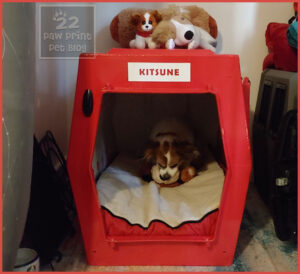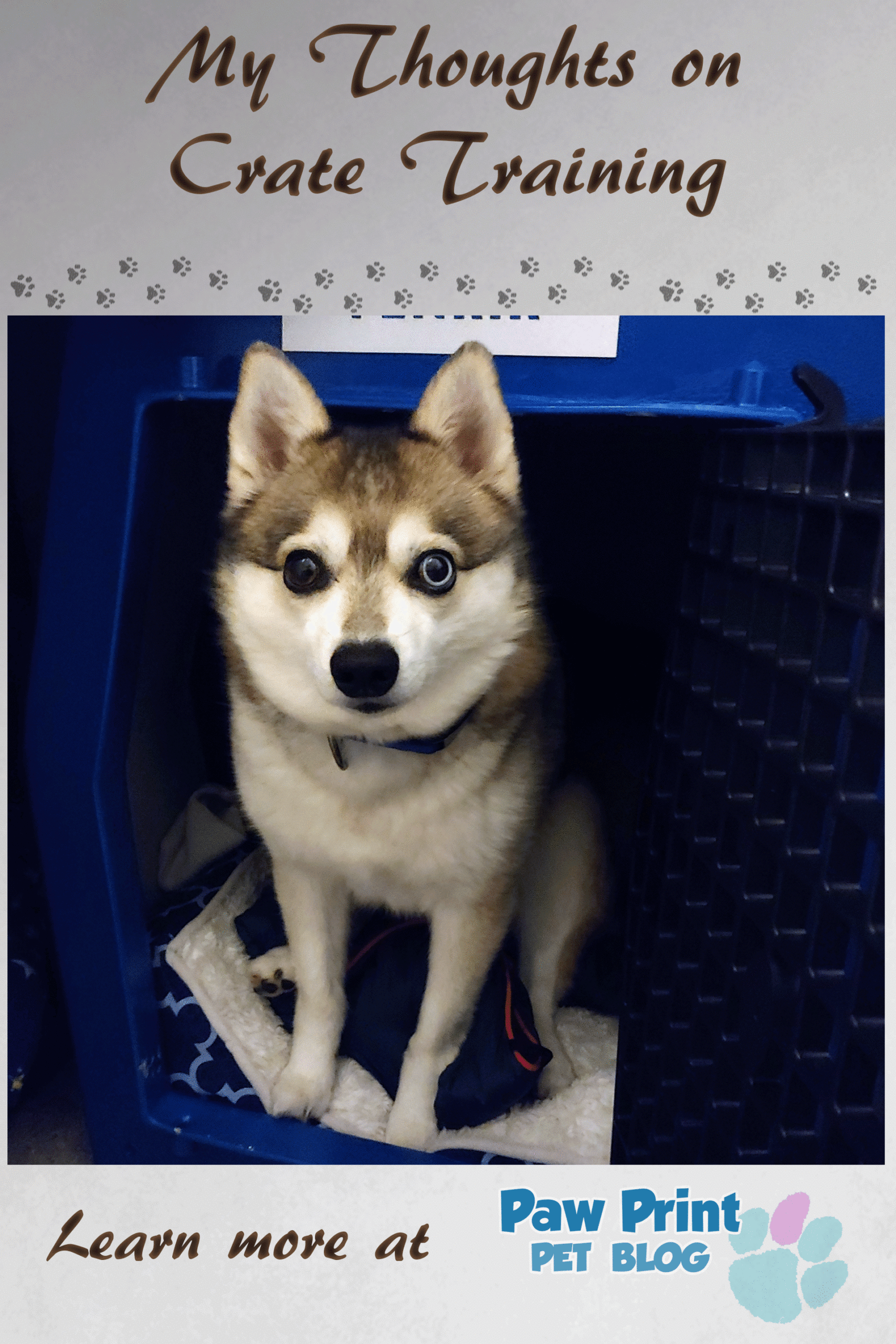
Crate training can be a pretty polarizing topic among dog lovers. Some owners swear by it, others feel that it’s cruel. I’ve received quite a few questions/comments about crate training since I posted a picture of Kitsune laying in an open crate on his Instagram account. I decided to write a post that outlines my current thoughts regarding crate training.
Post Contents:
- 1 There. My dogs in a crate. I guess that pretty much sums up my thoughts?
- 2 A crate is a tool. Like other tools, it can be used correctly or incorrectly.
- 3 Using a crate correctly, in my opinion, means actually crate training your dog.
- 4 Being comfortable in a crate can be a good skill to have.
- 5 I will say that crate training has been a positive experience for both Kitsune and Fenrir.
- 6 Crates can be abused/overused, I’m not naïve to that fact.
- 7 I personally think it’s important to give dogs a space of their own, where they can go when/if they feel like they need some time too themselves.
There. My dogs in a crate. I guess that pretty much sums up my thoughts?
 To elaborate – I’ve always loved animals. For the past 13+ years I’ve shared my life with dogs. Before them, though, I kept small/exotic type pets. Most exotic pets aren’t the types of animals you can let free range around your entire house. Even my house rabbits, who were fixed and litter box trained, had a large cage. They were only allowed to explore our apartment under strict supervision.
To elaborate – I’ve always loved animals. For the past 13+ years I’ve shared my life with dogs. Before them, though, I kept small/exotic type pets. Most exotic pets aren’t the types of animals you can let free range around your entire house. Even my house rabbits, who were fixed and litter box trained, had a large cage. They were only allowed to explore our apartment under strict supervision.
So I came from a background of utilizing cages for pets, mostly for their own comfort and safety. Awesome, decked out, usually pretty over the top cages – but cages nonetheless. Then enter Kitsune, my first dog. I’m pretty sure he was the most adorable puppy ever…

But puppies, even the cutest of them, are pretty much drunken, incontinent, sugar high toddlers X 1,000. I’m supposed to let this little beast roam around my house, doing whatever it wants 24/7!? I kind of want my security deposit back when I move, and I kind of like all my belongings intact. Most importantly, I need to make sure my new little beastling stays safe. Commence the crate training!
A crate is a tool. Like other tools, it can be used correctly or incorrectly.
When used correctly, for many dogs, a crate can be a safe, comfortable retreat. It can be used to teach your dog proper house manners, such as not relieving themselves indoors. It can be used to keep them safe when you aren’t able to directly supervise them.
Using a crate correctly, in my opinion, means actually crate training your dog.
It means building up a positive association with being inside their crate, not just sticking them in there and walking away. It means knowing your dog and being able to recognize if he/she is uncomfortable with being crated for any reason. Because, as you will probably see me write over and over again on this blog, all animals are individuals. Just because I say that crate training worked for my current dogs doesn’t mean I’m saying it will work for 100% of dogs. It’s up to each owner to decide what’s right for their individual dog and situation.
Related Posts:
- The Potential Dangers of Wire Crates
- Ruff Lands Kennels Dog Crate Review
- Painting Plastic Dog Crates
Being comfortable in a crate can be a good skill to have.
There are situations when your dog may need to be confined in some way. During an extended stay at the vets, for example, if you ever have to evacuate your home, or during travel. Situations like these can be stressful enough on their own, without the added hardship of being crated for potentially their first time. Being able to remain calm, even to relax and sleep, while crated is an important skill for a dog to have. It’s a skill that can really come in handy in emergency situations, and make otherwise stressful circumstances a bit less traumatic.
I will say that crate training has been a positive experience for both Kitsune and Fenrir.
 I crate trained Kitsune when he was a pup. He’s a very very smart dog. When he was just around a year old he really didn’t need to be crated anymore. He was 100% potty trained and respectful of our home and the stuff in it. Despite the fact that he no longer needed to be crated, we kept his crate set up in our bedroom. Over the first 10 months of his life we had worked to build a positive association with his crate. The sentiment stuck. Kit still to this day (he’s almost 14 years old now) likes to relax and sleep in his crate.
I crate trained Kitsune when he was a pup. He’s a very very smart dog. When he was just around a year old he really didn’t need to be crated anymore. He was 100% potty trained and respectful of our home and the stuff in it. Despite the fact that he no longer needed to be crated, we kept his crate set up in our bedroom. Over the first 10 months of his life we had worked to build a positive association with his crate. The sentiment stuck. Kit still to this day (he’s almost 14 years old now) likes to relax and sleep in his crate.
Fenrir still sleeps in his crate at night. Despite being 7 now, he’s never mastered the art of sleeping outside of his crate without waking everyone up multiple times a night. Fen will often even put himself to bed at night. He goes upstairs to sleep in his crate on nights when my partner and I decide to stay up later than usual. Fen also naps in his crate, with the door open, during the day.
We live in a rental house. It’s in our lease that our dogs are not to be left unsupervised if we’re not home. Hey, I get it. Sadly, some pet owners give the rest of us a bad rap, and landlords feel like they’re taking a risk renting to people with pets. My partner and I both work from home, so our dogs are not left home alone often. In the rare occasion that they are, we tuck them peacefully into their crates for a short nap until we get home.
Crates can be abused/overused, I’m not naïve to that fact.
I hate hearing stories of dogs who are forced to spend a majority of their lives locked away in a crate. However, that doesn’t mean crate training is inherently a bad thing.
I personally think it’s important to give dogs a space of their own, where they can go when/if they feel like they need some time too themselves.
I relate it to a person having their own bedroom – a safe space they can retreat too when they’re feeling overwhelmed with life and need some quiet time, or maybe just want to relax and take a nap. While crates are not the only way to accomplish this for our dogs, they are a good way to accomplish it – especially if, like us, you live in a home where space is at a premium. It’s a rule in our house that if our dogs are inside their crates they are to be left alone. They know that their crates are safe spots, a place they can retreat too when they, for any reason, need a bit of down time.
Crates may not be appropriate for all dogs but where appropriate and when used correctly, they can become safe retreats for beloved dogs. They can be used to protect your pet from stressful or potentially dangerous situations, or just to give your furry friend a comfortable place to call his own. It’s important, if you choose to use a crate for your dog, that you take the time to properly crate train and never force your dog to spend extended amounts of time in his/her crate.
I’d love to hear from you! Comment below – if you have dogs now or have in the past, did you crate train them?






No Comments